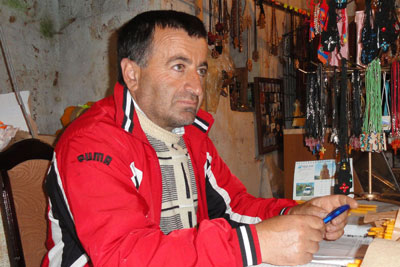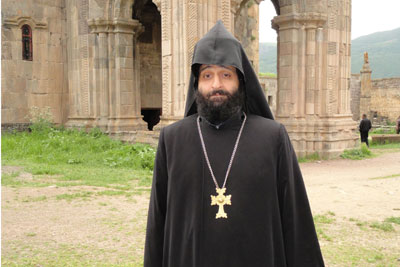
Sunday at Tatev: Many Visitors; Few Churchgoers (video)
The Sunday I visited the Tatev Monastery complex perched high above the Vorotan River in the Syunik Province of southern Armenia, I met up with a group of school pupils from Martuni.
Even though there were several plexi-glass information panels throughout the site, none of the children bothered to read them.
"Our teacher has already explained everything. Why should we read what is written," said Armineh, a young girl. "But it's nice to see the foreign tourists reading who built the church and when."
The pupils had arrived the night before and camped out under the walls of the 9th century monastery.
 Artashes Hovhannisyan, who sells candles and a variety of souvenirs, awoke at 7 the next morning to cater to the children.
Artashes Hovhannisyan, who sells candles and a variety of souvenirs, awoke at 7 the next morning to cater to the children.
Back in the 1990s, Artashes also sold candles and served as a watchman. He says that things have changed a lot at the monastery since then.
He told me that the monastery was registered as a working church in 1988 but that it never had a permanent pastor. A priest from Goris would make the trip to officiate at a wedding or baptism.
"But now we have our priest and everything is organized. The monastery has started to be renovated and since the opening of the aerial tram, the number of visitors has quadrupled," boasted Artashes.
The candle seller is referring to Monk (Abegha) Mikayel Gevorgyan.
 "Of course people come to ride the cable car and also to visit the monastery. Because of the improvements, many local villagers have also returned to the faith after all these years," said Mikayel Abegha.
"Of course people come to ride the cable car and also to visit the monastery. Because of the improvements, many local villagers have also returned to the faith after all these years," said Mikayel Abegha.
I asked the clergyman if this didn't mean that the populace of Syunik were without faith.
"That is hard for me to answer. Only God can look into the hearts of men and say that this person is a Christian and the other isn't. You know, each region has its good and bad points. It is well know that the people of Shirak are more faithful, but the populace of Syunik also have their good points like being steadfast and resolute. And sometimes this is manifested towards the clergy. But they are not strongly attached to the church. This we know."
Mikayel Abegha has made the monastery his home for the past three years.
"Prayers must be heard resounding in all the monasteries. This is very important," Mikayel Abegha said. "A German tourist who was visiting Tatev gave me some candles and requested that I light them. She said she wanted to return to Germany with the assurance that in far-off Armenia a light was burning in Tatev. This is to say that even though the world might be covered in darkness, Tatev will always be lit with a spiritual light of hope and prayer."
While baptisms and marriages take place all the time at Tatev, there aren't many congregants participating in Sunday worship services or for evening prayers.
Mikayel Abegha said that Tatev would be totally renovated by 2016, which will mark the 1110th anniversary of the Saints Paul and Peter Church was built between 895 and 906.
The Sts. Paul and Peter church is dedicated to the two apostles of Christ. It is also referred to as the Church of the Apostles or the Cathedral. It's likely that this church was built on the location of the old church and also inherited its name.
Sts. Paul and Peter church is the oldest remaining construction within the complex of the Monastery. St. Gregory the Illuminator and St. Mary are the two other churches in the complex that also includes a library, dining hall, belfry, mausoleum as well as other administrative and auxiliary buildings.
Another famous monument at Tatev is the pendulous column (Gavazan Siun) is a monument dedicated to the Holy Trinity. It is located to the south of the Cathedral. The column is about eight meters tall and is crowned with a cross-stone. It has few decorations and no inscriptions and has been left unaltered since its construction.
After Mikayel Abegha had given me a crash-course on Tatev's history, he said that he had to return to officiate at the Divine Liturgy.
I turned to see the school children scurrying to a waiting bus.
A group of tourists made their way to catch the next departing cable car for the village of Halidzor.
I was somewhat taken aback to see that none were curious enough to see what the singing emanating from the church was all about.
 Videos
Videos Photos
Photos




Comments (4)
Write a comment